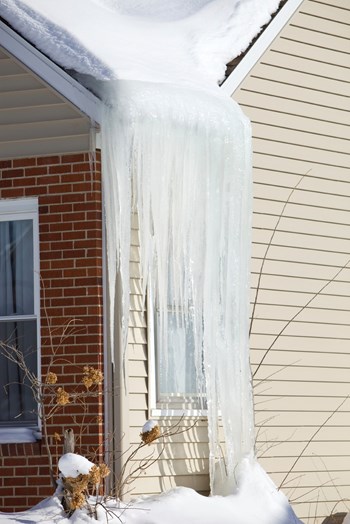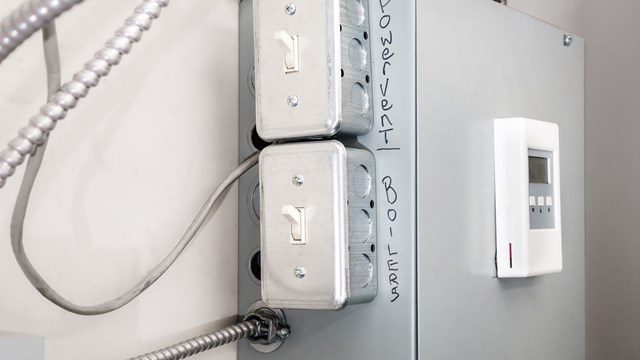
The birds are chirping, the trees are plush and green, and the beaches are lined with people. The record-breaking winter of only a few months ago, when inch after inch of snow piled up in New England, causing trouble for roads, businesses, and private homes—it’s hard to believe it ever happened. Summer months can offer their own insurance-related woes, like flooding and wind damage—but if last winter signified anything, it’s that New Englanders may need to start taking extra precautions against those below-freezing scourges. One primary culprit? Ice dams.
As many homeowners rudely found out: anice damis a ridge oficethat forms at the edge of a roof and prevents melting snow from draining off the roof. The water that backs up behind thedamcan leak into a home andcausedamage to walls, ceilings, insulation, and other areas.
For property managers and associations, John Raymond, president of JNR Gutters, Inc. of Haverhill, Massachusetts, offers some sage advice. He warns that memory is fleeting and prevention is the best solution. “Pretty much every condo can get ice dams, and then winter comes along and condo boards often take too long to figure out what to do. The problem is, people will forget over the summer, that this is a recurring problem… We had the same (ice dam) issues in 2011 and 2007,” Raymond says.
Insurance On Ice
Every New England homeowner has had some run in with cold-related damage. After last winter, many homeowners saw enough damage from the elements that it made sense to file a claim. Even insurance professionals were blown away with the explosion of claims among their condo association clients. Some form of coverage for snow and ice damage is a standard item in master policies for condo associations, and unit owners typically include it in their individual policies as well, says Brendan Kilcoyne, sales executive at H&K Insurance of Watertown, Massachusetts. He reports that, “We saw up to 95 percent of the units in a condo community affected by snow and ice damage this winter. In one place near Boston, with 144 units with three or four units per building, at least 82 homeowners filed claims, and this property was built in the early 2000s. Any kind of potential roofing issue was amplified this year,” he added.
“At another community, there were 26 out of 60 units affected, with water damage on ceilings, walls, floors… even wet insulation, which can become a real problem with mold. In this case, the master policy paid for the bulk of it.” The major caveat with ice damage coverage is the deductibles, he says, since, “There might be a $5,000 deductible which customers choose… to avoid raising the premium. Deductibles can be anything from $500 on an individual unit up to $15,000 on a master policy for the association.”
As far as whose policy is covering what ice damage, Kilcoyne notes, “It depends on the condo bylaws or the insurance policy language.”
While ice dam problems on roofs are nothing new in New England, the record-breaking snowfall of the 2014-15 winter was akin to nature’s “act of terrorism” in the opinion of one local roofer. Raymond recalled the record-history snowfall draining his resources. “We had 100 men in the field and we couldn’t keep up with requests. The problem was that everyone waited until after 100 inches had already come down in one month. We saw pitched roofs as well as flat roofs that collapsed. I saw ice dams that let go and took out air conditioners… icicles coming down and ripping the pipes right off buildings, chunks of ice breaking skylights…”
“Condo boards only budget for their landscaping contractors, in winter, to clear snow that’s on the ground but those guys aren’t going up on the roof.” It can be just as important to clear snow from roofs, so that should be considered in budgets as well, Raymond contends, adding, “When no one factors in the cost of taking snow off the roof, management will be on the hook. The good managers know to come up with a plan and decide what’s most cost effective” to avoid snow and ice damage in the upcoming winter.
Ice dams not only push water into interior spaces, but can trap water on roofs, pushing the weight-bearing limit—a problem, he notes, “especially on old buildings with flat roofs. When they were built, the building code was insufficient for extra snow load.” Raymond points out that building codes and energy codes have changed in recent years, “so that it’s up to R-50 for insulating attics now. That’s why condo boards should hire engineers” to assess what the structural situation is and if it can be improved—brought up to newer codes—and better winter protection. “We’d like to see boards and managers develop a proactive plan for snow removal. Our company is putting plans in place for our own condo customers.”
The Best Defense is a Good Offense
The best defense, not surprisingly, starts with a new roof. Raymond explains that an “ice and water shield” is installed under the shingles when re-roofing is done. This is an impermeable lining fabric, sold in rolls three or more feet in width, that is designed to seal around roofing nails and is very effective in preventing water infiltration from ice dam backups.
Barring roof re-construction, a more immediate fix includes heat cables or tapes, at the roof edges, on gutters and downspouts. The downside, says Raymond, “is the cost of electricity. Plus, there are different levels of quality, and a commercial-grade is a must. And the fasteners used to install the heat elements don’t work for old, brittle roofs.” Another structural solution is to install metal panels along the roof edges, so that snow just slides off, he adds.
Snow building up and then sliding off from its own weight may save the roof but can cause a whole other set of catastrophes. Mike McDuffee, project manager at Corolla Roofing of Winthrop, Massachusetts, has observed winter’s “terrorism” as well. “We saw ice buildups that tore the gutters and downspouts off of roofs, in several locations. On steep, slate roofs, the snow and ice came off like an avalanche, wrecking gas meters and A/C units…. anything attached to the building. On lower sloped roofs, the snow and ice would cantilever off the edge like a slow-motion glacier… like a frozen ocean wave coming down.”
“One building had its fascias (at the roof edge) torn right off,” he notes. However, the weather stress exposed vulnerabilities in the construction, since “sometimes these fixtures weren’t secured very well when they were originally installed.”
With metal or slate roofs, McDuffee explains, “some contractors install snow clips or guards, or a ‘snow fence’ a few inches tall, near the roof edge,” to retain the snow and avoid an ice fall or slide.
Some of the most vulnerable roofs can be on the newest buildings, he continues. “When sloped roofs have dormers built close to the roofline, ice dams back up into the side walls of the dormers. The ice and water shield (that’s installed under the shingles) needs to be integrated with the side walls of the dormers, wrapping up the sides a good 18 inches.” McDuffee points out that flat roofs sometimes handle ice and snow better than sloped roofs, depending on how they’re designed. “With a roof pitch of more than a three-inch rise for each level foot, shingles are generally installed,” he notes. “A lower pitch would get a membrane. On a flat roof, if there’s a center drain, it’s warmer there and the water keeps flowing under any ice or snow and into the drain. It’s when water drains to the outside edge of a roof, whether it’s sloped or flat, then it’s going to freeze… It’s always colder at the edge of a roof.”
And the flat roofs in Boston were not immune. These roofs are constructed with scuppers around the perimeter. Scuppers are drains or openings through the roof rail—the rim that tops the building’s outside walls and “fences in” the roof. “We saw situations where the scuppers got iced up and frozen shut… and the roof became a bathtub.” One solution “is to warm those drainage features at the roof’s edges, the scuppers, gutters and downspouts, with special heat tape,” he advises.
The other major problem that plagued building managers last winter, especially in urban neighborhoods, was dumping all that snow. “We were asked to service a high-rise in Boston and remove snow and ice from their flat roof, and we asked, ‘Where should we put the snow?’…” and that effectively ended the conversation. “We tried to take care of our regular customers and management companies first. For some properties, we hired dump trucks and hauled the snow out. At one site, west of Boston, we cleared a flat roof on a three-story building and had to bring in a crane to swing the loads of snow into a pile beyond their parking lot.”
“Our clients had to realize what a major operation this snow removal became,” McDuffee continues, “… It could take three hours just to get to a site with vehicles and extra staff, and make our way through the snow piles with ladders and equipment; setting it all up and then taking it all down… People didn’t take all this into account.”
What Can You Do?
Sean Kidd, co-owner of Kidd-Luukko Corp. in Worcester, Massachusetts, has seen similar tales of woe and destruction at his clients’ properties. “At a property built in the early 1980s, we saw massive ice buildup, 12 to 18 inches thick in the eaves and valleys with extensive damage to the asphalt shingle roof. At a three-story building in Fall River, the manager waited too long, then called our firm to shovel the roof, but the damage was already done,” he states. “Massive leaking had already happened by the time we got there. We used 40-foot ladders… set up ropes and harnesses to lower workers with shovels to the roof edges, and had to chip the ice although this is not recommended—but this was an emergency—and we had to remove the snow as well.”
He agrees with other roofing experts that the best defense is in a new roof lined with ice and water barrier, but warns, “It only works where you put it… It has seams and it overlaps and must be installed properly. Plus, with all the roofing nails, if some come out, that leaves openings, and there is also expansion and contraction (of materials). This is why the manufacturers don’t warrant against ice damage… They can’t control workmanship, so it’s not necessarily 100 percent effective, although some clients have never had to shovel.”
He points out that “ice and water shield is now part of the building code, and it specifies installing it at least two feet inside the ‘warm wall,’ which is the point near the roof edge where the (heated) interior space begins,” so it’s the roof overhang plus wall width plus two feet that must be shielded. Kidd adds, “Remember that shingled roofs are only designed to shed water, they’re not waterproof.”
As an add-on measure, he considers heat cable or tape “as a possible very good solution, but it’s situational. We’ve gone back and forth with heat tape. It can backfire if not installed in just the right place … creating ice dams below,” where water melted and re-froze.
To mitigate future problems, Kidd recommends, “First, have a professional assess your roof and see if improvements can be made. Sometimes shingle roofs can be changed to rubber (membrane) or metal. Be ready for snow or ice events — people can set up contracts with a roofing company to provide first right-of-refusal for snow removal from roofs… and it may seem obvious, but it’s important to watch the weather.”
Kidd notes that planning for emergencies can only go so far. “Even associations that were proactive and got their roofs cleared of snow right away got socked with more storm events after they had used up their entire snow removal budgets,” he contends. “Sometimes you have a good roof and I really cannot make more improvements to it—you just have to clear the snow off it, but no one wants to hear that. You have to view it the same way as clearing the driveways and walks.”
Marie Auger is a freelance writer and a frequent contributor to New England Condominium.






Leave a Comment